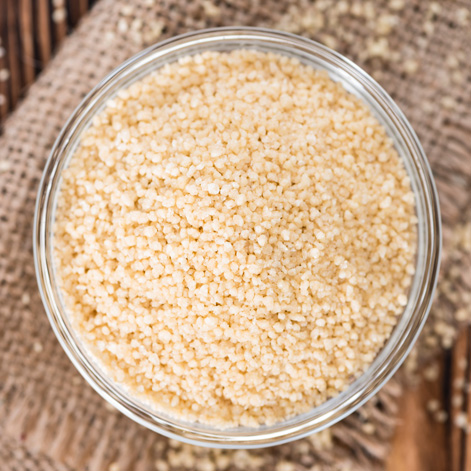Couscous was traditionally made from durum wheat semolina, a sort of granular flour produced by coarsely grinding it on primitive millstones. Today, however, Couscous may also refer to a food made from other grains, such as corn, sorghum, rice, barley, and millet. Couscous is generally served with stewed meat or boiled vegetables, but in some areas it's also served with stewed fish. Couscous can also be spicy, if served with harissa sauce, a sauce that is typical to North Africa.
Origin
When we speak of Couscous, we're talking about a dish that comes directly from the countries of North Africa. No other flavor is so closely tied to the history and traditions of Arab people as Couscous, especially for the Maghreb.
However, its history is not limited to just this side of the Mediterranean. Because of trading routes, Couscous also arrived in Spain, France, and in Sicily many hundreds of years ago.
Regarding its origin, establishing an exact date is impossible.
Some news comes to us from the Berbers, inhabitants of the mountains and valleys of the Maghreb, even before the 7th century A.D. To prepare what may be termed an ancestor of Couscous, the Berbers used mainly wheat, or millet and barley, from which they gleaned a type of semolina that was kneaded with water or milk. In this way, they obtained rudimentary dishes called “kskso” or “kuski,” hence the name Couscous.
WHY IT SHOULD BE EATEN
Couscous, like all grains, has complex carbohydrates and B vitamins, nutrients that release energy slowly. According to recent studies on durum wheat grains, the grains that make up Couscous are high in fiber content and help stimulate the intestines and aid the body to get rid of harmful waste that can promote the formation of tumors, such as colon cancer.

Couscous is a semolina of durum wheat that is steam processed to form small granules, which are then dried. In the kitchen, it lends itself to both sweet and savory dishes: perfect as a one-dish meal when combined with meat, fish, and vegetables, it becomes a healthy but delicious dessert if served with fruits, either fresh or dried, and with honey or yogurt.
Commercially, Couscous is generally available precooked, and one does not need the traditional couscoussier to cook it. To prepare it, just add a little oil to the product, work it through your fingers and cover it with a quantity of water equal to the weight of the grain.
For example, for 100 grams of Couscous, you will need 100 milliliters of boiling water or broth, and 1 tablespoon of extra-virgin olive oil. The water should be slightly salted, or you can use a light broth to make a more flavorful dish. Once the water is poured over the couscous, it should be mixed and then covered, so that it puffs up. It should be just left to sit for 5-10 minutes.
Once the time has elapsed, the Couscous will have completely absorbed the liquid, and it will be slightly puffed up. Work the grains with a fork once again, and then season to taste.

The traditional North African dish is the star, indirectly, of a 2007 French film, winner of the Silver Lion at the Venice Film Festival, which was distributed in Italy with the title, “Cous cous.” In the feature film, the Maghreb, Slimane, a sixty-one-year-old shipyard worker, resigns from his job and decides to open a restaurant on a boat to serve Couscous, the pivotal dish cooked by his ex-wife.


 Back
Back




